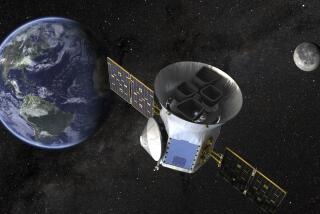For First Time, Planet Found Basking in the Rays of Three Suns
Astronomers have detected the first planet in a solar system with three suns, a finding that challenges prevailing theories about planetary creation.
Using the Keck I telescope atop Mauna Kea in Hawaii, Maciej Konacki of Caltech found the gaseous planet in the star system HD 188753, located 149 light-years from Earth in the constellation Cygnus.
The system is made up of two stars that spin around each other while orbiting a large central star, according to a report in the current issue of the journal Nature.
The gas planet, which also orbits the large central star, is about the size of Jupiter.
“The sky view from the surface would be spectacular, with an occasional triple sunset,” Konacki said.
He began studying the distant solar system in 2003. He detected the planet by observing tiny gravitational tugs, exerted by the planet and the two smaller stars, that caused the central star to wobble.
The planet poses a conundrum for theoreticians.
Standard theories hold that large gas planets can only coalesce when they are at least three times as distant from their central star as the sun is from Earth. Any closer and the heat of the sun would prevent the planet from forming, the theories say.
The new planet is 4.3 million miles from the central star. Earth is 93 million miles from its sun.
The planet could have wandered there from a more distant orbit -- except that the outward gravitational force of the paired stars would have made that migration impossible.
“This planet should not exist,” German astronomers Artie Hatzes and Gunther Wuchterl wrote in an accompanying commentary in Nature.
Konacki said the findings suggested that planets could form in far more diverse environments than scientists had believed.
Caltech astronomer Shri Kulkarni said: “This is good news for planets.... They may live in all sorts of interesting neighborhoods that until now have gone largely unexplored.”






